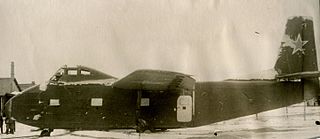Related Research Articles
The JSC A.S. Yakovlev Design Bureau is a Russian aircraft designer and manufacturer. Its head office is in Aeroport District, Northern Administrative Okrug, Moscow.

The Yakovlev Yak-40 is a regional jet designed by Yakovlev. The trijet's maiden flight was in 1966, and it was in production from 1967 to 1981. It was introduced to service in 1968, with export models following in 1970.

Alexander Sergeyevich Yakovlev was a Soviet aeronautical engineer. He designed the Yakovlev military aircraft and founded the Yakovlev Design Bureau. Yakovlev joined the Communist Party of the Soviet Union in 1938.

The Yakovlev Yak-11 is a trainer aircraft used by the Soviet Air Force and other Soviet-influenced air forces from 1947 until 1962.

The Yakovlev Yak-141, also known as the Yak-41, is a Soviet supersonic vertical takeoff/landing (VTOL) fighter aircraft designed by Yakovlev. Intended as a replacement for the Yak-38, it was designed as a supersonic fleet defence fighter capable of STOVL/VTOL operating from Soviet carriers. Four prototypes were built before the project's cancellation.

The Yakovlev UT-2 was a single-engine tandem two-seat low-wing monoplane that was the standard Soviet trainer during World War II. It was used by the Soviet Air Force from 1937 until replaced by the Yakovlev Yak-18 during the 1950s.

The Yakovlev Yak-18 is a tandem two-seat military primary trainer aircraft manufactured in the Soviet Union. Originally powered by one 119 kW (160 hp) Shvetsov M-11FR-1 radial piston engine, it entered service in 1946. It was also produced in China as the Nanchang CJ-5.

The Yakovlev Yak-130 is a subsonic two-seat advanced jet trainer and light combat aircraft originally developed by Yakovlev and Aermacchi as the "Yak/AEM-130". It has also been marketed as a potential light attack aircraft. Development of the aircraft began in 1991 and the maiden flight was conducted on 25 April 1996. In 2002, it won a Russian government tender for training aircraft and in 2010 the aircraft entered service with the Russian Air Force. As an advanced training aircraft, the Yak-130 is able to replicate the characteristics of several 4+ generation fighters as well as the fifth-generation Sukhoi Su-57. It can also perform light-attack and reconnaissance duties, carrying a combat load of 3,000 kg (6,600 lb).

The Yakovlev Yak-14 was the largest assault glider ever to enter service with the Soviet Air Force. It was introduced in 1949, at a time when other air forces were abandoning the glider concept. In 1950 a Yak-14 became the first glider to fly over the North Pole.
The Yakovlev Yak-5 was an experimental trainer aircraft designed by Yakovlev OKB in the Soviet Union, and first flown in 1944.

The Yakovlev AIR-1 (VVA-3) was a 1920s Soviet two-seat light biplane, the first aircraft designed and built by Aleksandr Sergeyevich Yakovlev.

The Yakovlev AIR-3 was a 1920s Soviet two-seat general aviation monoplane designed and built by Aleksandr Sergeyevich Yakovlev.
The Yakovlev AIR-6 was a Soviet light utility aircraft of the 1930s. It was a single-engined high-wing monoplane designed by Alexander Sergeyevich Yakovlev, with 128 being built.

The Yakovlev AIR-7 was a prototype Soviet high performance light aircraft of the 1930s. It was a two-seat single-engined monoplane, which demonstrated excellent performance during testing. After the prototype almost crashed as a result of flutter, its designer, Alexander Sergeyevich Yakovlev suffered temporary disgrace and no production followed.

The Yakovlev AIR-5 was a prototype Soviet single-engined cabin monoplane designed by the Yakovlev design bureau. The AIR-5 was a high-wing strut-braced monoplane with a 200 hp (149 kW) Wright J-4 Whirlwind engine. It had a tubular steel fuselage, wooden wings and an enclosed cabin for a pilot and three passengers.

TheYakovlev AIR-9 / AIR-9bis was a 2-seat sport aircraft designed and built in the USSR during the early 1930s.
The Yakovlev AIR-12 was a long-range sport aircraft designed and built in the Soviet Union during the late 1930s.
The Yakovlev AIR-11, also known as Yakovlev LT-1, was a 3-seat low-wing touring cabin monoplane designed by A.S. Yakovlev in the USSR, circa 1936.
The Yakovlev AIR-16, also known as Yakovlev LT-2 or Yakovlev No.16 was a 4-seat cabin monoplane touring aircraft, designed and built in the USSR during 1937. Intended to be powered by a 220 hp (160 kW) Renault Bengali 6 engine, the AIR-16 was never flown. Sources differ but in his memoirs, Yevgeniy Adler, Kotovs successor, put the failure to fly down to inherent design weaknesses that were not able to be rectified.
The Yakovlev Yak-201 was a planned Russian vertical takeoff and landing stealth fighter/interceptor aircraft for the Russian Navy, as a follow-up to the Yak-141 and Yak-43 aircraft. The design was carried out in the mid-1990s Yakovlev Design Bureau. The project was cancelled and no prototype was built due to a lack of funds and interest by the Russian Ministry of Defense.
References
- ↑ Gordon, Yefim; Dmitry; Sergey Komissarov (2005). OKB Yakovlev . Hinkley: Midland Publishing. p. 36. ISBN 1-85780-203-9.